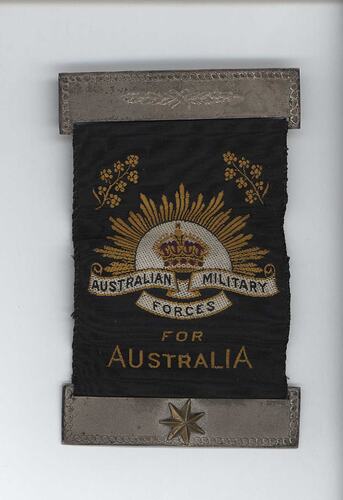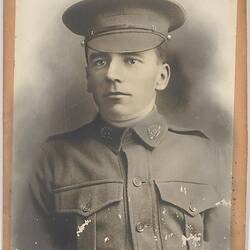Summary
Alternative Name(s): Mothers & Widows Ribbon
Presented in memory of Pte Albert Edward Kemp, who was killed in action on the Western Front in World War I in 1917. The ribbon would have been given to either his wife or his mother.
Albert Edward Kemp was a 32-year-old butcher living in Caulfield and married to Annie Josephine, when he enlisted. He and Annie had a daughter, Ethel Mavis, and a baby son, George Percival. Albert enlisted at Royal Park on 4 October 1916, and was assigned to the 22nd Reinforcements, 6th Battalion - regimental number 6800. His battalion left Melbourne 25 October 1916 - just 21 days after he enlisted. He was shipped to France on 27 March and was taken on strength on 4 April. On 21 September 1917, Albert died in the trenches in Glencorse Wood, Belgium. His body was never recovered. He is commemorated at 29 The Ypres (Menin Gate) Memorial, Belgium.
According to the Australian War Memorial, the badge was officially sanctioned in Military Order 64 of 1919. The Barrier Miner (NSW) announced on 4 June 1919 that badges were now being issued to the mothers and widows of those 'who have been killed in action or died of wounds or other causes while serving, or who after discharge died from causes directly attributable to wounds or sickness incurred while on service'. Appropriate wear was prescribed: 'When the badge is worn it should be attached to the dress, on the right breast'. A total of 30,000 badges were ordered (although over 60,000 were killed). Delivery was delayed due to power restrictions during 'the strike' (thousands of seamen were involved in industrial action during 1919), and the contractor struggling to produce the necessary quality for the metal bars.
Physical Description
Black ribbon with one star in card box. Inscribed. Golden wattle motif; rising sun with crown at centre; one star at bottom
More Information
-
Collection Names
-
Collecting Areas
-
Acquisition Information
Purchase from Mr Jeff Kemp, 07 Dec 2006
-
Date Made
-
In Memory Of
Private Albert E. Kemp - 6th Battalion, Australian Imperial Force (AIF), Malvern, Greater Melbourne, Victoria, Australia
6800 Pte A.E. Kemp, 6th Battalion, A.I.F. -
Inscriptions
Text, embroidered: AUSTRALIAN/MILITARY/FORCES/FOR/AUSTRALIA.
-
Classification
-
Category
-
Discipline
-
Type of item
-
Object Measurements
6.2 cm (Width), 0.5 cm (Depth), 10.5 cm (Height)
-
References
Australian War Memorial Encyclopaedia, 'The Mothers and Widows Badge', [Link 1] accessed 27 Mar 2013. MOTHERS AND WIDOWS' BADGES. (1919, June 4). Barrier Miner (Broken Hill, NSW : 1888 - 1954), p. 1. Retrieved March 27, 2013, from [Link 2] WAR BADGES FOR WOMEN. (1919, September 19). The Argus (Melbourne, Vic. : 1848 - 1956), p. 6. Retrieved March 27, 2013, from [Link 3]
[Book] Hutchinson, Garrie. 2009. Remember Them; a Guide to Victoria's Wartime Heritage., 30-2 Pages
-
Keywords
Death & Mourning, Domestic Life, Wars & Conflicts, World War I, 1914-1918, Making History - Kemp Mourning Collection


